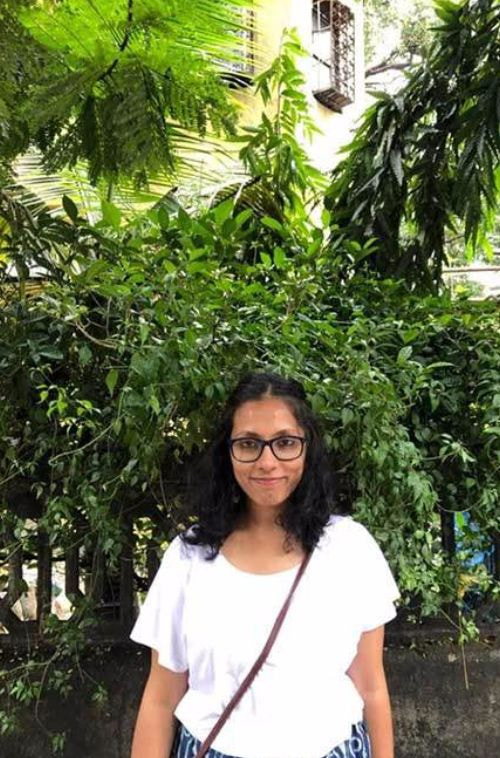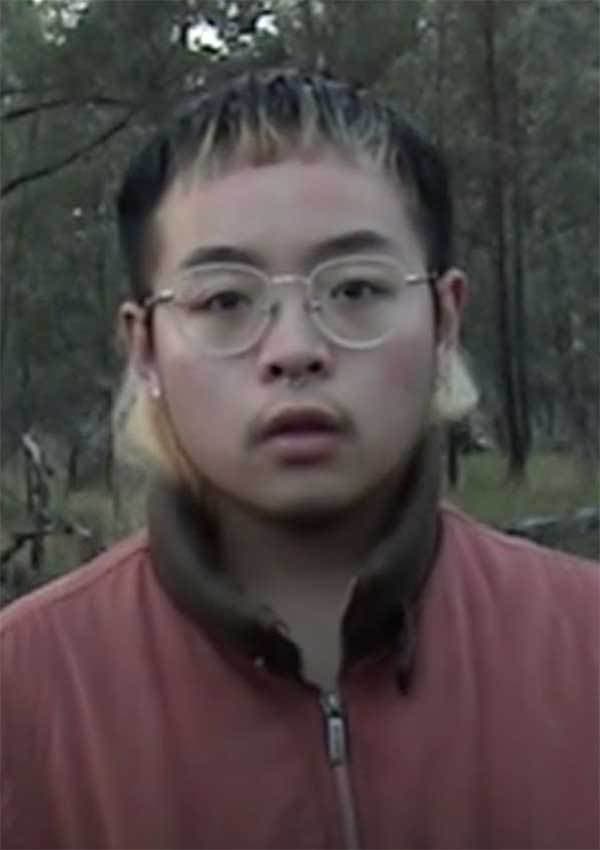4分33秒を3回: 一人のアーティストと一脚の椅子へのオマージュ
監督・編集 ダフナ・メロ
[イスラエル 2018]
4'33'' Times Three: Homage to an Artist and a Chair
Director and editor:Daphna Mero
[Israel 2018]
A film by Daphna Mero
Director and editor: Daphna Mero
Producers: Yael Mero and Daphna Mero
Cinematography: Daniel Bar
Original Music and Sound Design: Lior Pinsky
With Amos Hetz
(4.33 was composed and performed by Amos Hetz at the 2013 'Room Dances' festival.Parts of this piece were performed in the film by the artist himself)

ダフナ・メロ
映画監督、振付家、プロダンサー。エルサレム音楽舞踏アカデミー学士(舞踊)。ミンシャー芸術学校学士(映画)。マサチューセッツ芸術大学美術学修士(映画)。場所、空間、風景にインスパイアされた作品創作を行う。視覚芸術とダンスを物語を介して取り入れ、体験を創出している。世界各国の映画祭で短編実験映画が上映と受賞されている。
Daphna Mero
Daphna Mero is a film director, choreographer and a professional dancer.
She holds a B.Dance from the Jerusalem Academy of Music and Dance, a film diploma from Minshar for Art, Tel-Aviv and MFA in Film/Video from MassArt, Boston. Her work draws inspiration from locations, spaces, and sites. They deal with the human experience via a novel medium, which incorporates visual art and dance. Her short experimental films have been screened in film festivals around the world, and she has won many awards and prizes for her work.
ダンス映画監督たちへのメールインタビュー
インタビュアー・翻訳:黒田瑞仁
Q:
ベテランダンサーの思考が丁寧に示される、興味深い作品でした。とくに、誰かに見せるためというよりも、プラクティスとしての踊りを感じました。ところで、あなた自身もダンサーで振付家ですね。あなたは彼の踊りとどこで出会い、あなたは彼の踊りと理論についてどう思っているのでしょうか。
A:ダフナ・メロ
アモス・ヘッツ教授はエルサレム音楽舞踏アカデミーで私の母に動作と踊りの記述法を教えた先生でした。
若いダンサーだった10代の頃、私は母と一緒に彼が立ち上げたルーム・ダンス・フェスティバルに彼のパフォーマンスを観に行きました。彼のミニマルなダンスはエシュコル・ワックマン式記譜法と1960年代のミニマル・アートに影響を受けています。その抽象的な踊りは紙の上で記述され振り付けられるのです。そしてパフォーマンスは大抵メトロノームと共に行われます。
暫くして、私はダンスの学位取得に向けてエシュコル・ワックマン式記譜法について知ることになります。しかし若く活気にあふれた新参ダンサーだった私は、クラシックバレエ、モダンダンス、コンテンポラリーダンスを学んでいたものの、彼のような踊りの手法に関心や興味を示すことはありませんでした。その精密さにいつも感心していたにも関わらず、です。
アモスの抽象的で分析的なダンスは私が習得した踊りとも、当時の私のダンスへの考え方とも違っていたのです。そんなある日、彼の椅子とのデュエットを観ました。頭の中で何かが噛み合う音がしました。私は感情的に動かされ、惹かれ、夢中になりました。今回はアモスに出会い、彼のアートや踊りや椅子についての思考を聞く絶好の機会でした。アモスは彼の動作についての知識と哲学を惜しみなく私と共有してくれました。長い話を何度かしました。その内容をこの短編映画で、彼のミニマルな表現を引用して伝えています。
Q:
今度は映画監督としてのあなたに質問です。この作品はダンスだけでなく、彼の人間味が伝わる映画でもあったと思います。彼の語りがまるで4つ目の踊りのようでした。あなたが彼にインタビューし、撮影し、編集する過程でこだわったのはどのような部分でしょうか。
A:ダフナ・メロ
私はアモス・ヘッツ教授と彼の芸術を深く尊敬しています。この映画は彼の「動作作曲 4分33秒」(2015)へのオマージュなのです。
アモスは当初ダンスのことだけを話すつもりだったようですが、私から彼にアーティストとしてのステートメントを書くように依頼し、それをカメラの前で読んでもらいました。それから彼に踊りの3つのパートを解説し、実演してもらうよう頼んだのです。それはゆったりとしたインタビューでした。私は彼に大きな質問を投げかけ、彼はそれについて邪魔されずに語りたいだけ語ったのです。インタビューの間、彼は先生で私は意欲的なダンス学生でした。インタビューが終わりに差し掛かったとき、親しくて魔法のような時間が流れました。アモスが子供時代の思い出を私に語ってくれたのです。
撮影に際して、私は彼の「いかなる舞台装置の助けも借りず、動きだけがあるダンスこそ、自立した体験をもたらすことができる」という思想に当てはまるような映像言語を探しました。そこで私は抽象的でミニマルなロケーションを選び、幾何学的で緻密なフレーミングを行いました。照明は自然光を採用しました。コントロールされていない自然光は、即興的な態度でダンスに寄り添ってくれました。
編集段階では、アモス自身の踊りがそうであるように映画を章立て形式にすることにしました。踊りと喋りを織り交ぜながら、分析的な視点から私的な視点に移行させていきました。彼の芸術を尊重するため、踊りのパートには音を重ねず静かなままにしました。彼が語るパートに重ねるために、実験音楽家と一緒に曲を作りました。こうして彼の語りはこの映画の音楽となり、あなたが言うように4つ目の踊りが形成されたのです。
A Mail Questionnair to Dance Film Directors
Interviewer : Mizuhito Kuroda
Q:
The film was a very fine documentary, introducing the mind of an experienced dancer carefully. I felt his dance was more of a practice than an entertainment for the audience. As a dancer and a choreographer yourself, how did you get to know his dance, and what do you think about his dance and theories?
A:Daphna Mero
Professor Amos Hetz was my mother’s movement and dance notation teacher at the Jerusalem Academy of Music and Dance.
As a teenager and a young dancer, we used to go together to his performances at the "Room Dance festival" which he founded. His minimalistic dance is rooted in the Eshkol-Wachman movement notation and the minimalistic arts' movements of the 60th. It is an abstract dance that is written and choreographed on paper just like a music score. It is usually performed accompanied by a metronome.
Later, in my studies towards my BA in dance I came to know Eshkol-Wachman movement notation better. But being a young, vibrant, and updated dancer that studied classical ballet, modern and contemporary dance, I didn’t feel any connection or interest in this kind of dance. Though I was always impressed by its precision.
Amos' abstract and analytical dances were very far from my dance practices and perceptions of dance. And then I saw the chair-duet. There was a click. I was emotionally moved, intrigued, and fascinated. It was an opportunity for me to meet Amos and hear his thoughts about art, dance, and chairs. Amos gladly shared with me his movement knowledge and Philosophy. We had long talks. They are conveyed in my short film using his minimalistic way of expression.
Q:
The next question is for you as a director. I was delighted to see this film to know his personality and not just his dance. His talk was like the 4th dance in the film. How did you interview, film, and edit to show this one person?
A:Daphna Mero
I have great honor to Professor Amos Hetz and his art. Hence the film is an homage to his Movement Composition 4.33 (2015).
As Amos was willing to talk only about the dance, I asked him to write an artist statement and read it aloud to me in front of the camera. I also asked him to explain and demonstrate the 3 parts of the dance. It was a slow interview. I used a set of open questions and let him talk uninterruptedly on what he wanted and as long as he wanted. All along the interview he was the teacher, and I was the attentive dance student. Towards the end of the interview there was an intimate, magical moment. Amos shared with me a childhood memory.
In the process of shooting the film I looked for a filmic language that will comply with Amos' notion of "a dance form in which movement alone, unaided by any stagecraft, is able to provide an autonomous experience". I chose a minimalistic location that almost looks abstract and framed it in a very precise and geometrical way. I chose natural lighting, which was uncontrolled and accompanied the dance in an improvisational way.
I decided to edit the film in chapters much like Amos' dance. Intertwining dance and talk going from the more analytical to the personal. With respect to his art, I decided to keep the dance part silent. I worked with an experimental musician on creating music for his talk. Thus, the words become part of the musical score of the film and with it a form of 4th dance as you mentioned.
点描のからだ
監督:プラクリティ・シャーダ, サガリカ・デブナト
[インド 2020]
Dotted Bodies
Director:Prakriti Sharda, Sagarika Debnath
[India 2020]
Director: Prakriti Sharda, Sagarika Debnath
Cast: Kashish Kalia, Riya Singh, Shankar Rawlley, Prakriti Sharda, Gaurav Rawat, Shankar Rawlley
Dialogues: Kashish Kalia, Prakriti Sharda, Annanyaa Singh, Pragya Kapur

プラクリティ・シャーダ

サガリカ・デブナト
プラクリティ・シャーダ
サガリカ・デブナト
元気な哲学専攻の学生と、退屈した工学専攻の卒業生が出会うとどうなるか?
これは偶然の映画です。
プラクリティ・シャーダはアートディレクターになりたかった。サガリカ・デブナトの夢は映画作り。二人は小さな喫茶店で日がな一日、映画、音楽、雑誌を論じて過ごしました。写真のプロジェクトとして始まった企画が、記憶とムーブメントの実験になりました。
Prakriti Sharda
Sagarika Debnath
What happens when an enthusiastic philosophy major and a bored engineering graduate meet? An accidental film.
Prakriti Sharda aspires to become an art director, while Sagarika Debnath dreams of making films. They spend their evenings at a tiny coffee shop, debating over films, music and zines. What started out as a photo project, evolved into a study of memories and movement.
ダンス映画監督たちへのメールインタビュー
インタビュアー・翻訳:黒田瑞仁
Q:
ドキュメンタリーとフィクションが混ざり合った、とても不可思議な作品です。全てを疑おうと思えば疑えてしまいます。このような推理をさせるダンス映画はなかなかありません。どこから着想を得たのですか。内容のどの程度がフィクションで、どの程度がドキュメンタリーなのでしょうか。
A:
『点描のからだ』は偶然の発見と、真実と、ダンス創作の力学の混成です。この作品は実話に基づいたドキュメンタリーで、作中に登場するダンサーたちが実際に体験した出来事です。
写真プロジェクトからスタートした本企画の目的は、踊りにいかに物悲しさが潜り込むかを捉えることでした。企画段階ではまだ映画を作ろうなんて思ってもいませんでした。私たちが運がよかったのは、素晴らしいダンサーたちとプロジェクトの途上で出会い、たくさんの会話を交わしたことで、この物語にたどり着いたことです。ダンサーたちが何年か前に実際におこなった海外公演で出くわし、感じ、体験した出来事についての物語。この物語は聞いた時には私たちに深い印象を与えましたが、それでもまだ映画にできるとは思っていませんでした。しかしある日の午前3時に撮影した全カットを見返していた時、何時間もスクリーンを眺めて手のゆらぎと目のちらつきを確認していた時、2つのパズルのピース(かつてダンサーたちに起きた出来事と、それから何年も経ったあとの同じ彼女たちの動き)がぴったりと重なりました。そこではじめて、映画を作ることにしたのです。
Q:
『点描のからだ』はある舞台作品をめぐる謎について語られる作品ですが、この舞台の謎に直接は関係のないバスルームなどの生活空間や日用品のイメージが何度も挿入されるのが興味深く、登場人物の身体を感じました。なぜこのように一見本筋には無関係なシーンを多く挿入したのでしょうか。
A:
踊ることが常に喜びに結びつくとは限りません。ダンサーたちがこの映画のためのリハーサルをしたとき、彼女たちは自分の体を自分のものと思わず、あくまで自分の感情と受け取った体験を運ぶ器だと信じて踊ったのです。私たちはこの撮影の日々の中で、彼女たち自身が体験したこの奇妙で本当の出来事に出くわしたのです。
つまり、この映画は撮影が先に行われ、後から筋書きができました。写真も映像も屋内で撮影されましたが、その日々のなかでも外に出て生活を続けるダンサーたちの姿は、異界の空気と空間がダンサーたちを何年も前に舞台上で呑み込んでしまった記憶がいまだに彼女たちの動きに呪いをかけ、影響しつづけていることの何よりの証拠なのです。
A Mail Questionnair to Dance Film Directors
Interviewer : Mizuhito Kuroda
Q:
Dotted Bodies is such an uncanny piece, fiction and documentary mixed. You cannot tell what to believe and what to doubt. This is the first time I came across such a mystery dance film. Where were you inspired from? How much of this is fiction and how much is documentary?
A:
Dotted Bodies is an amalgamation of accidental discoveries, truths and the power of recreation through dance. The film is a documentary based on a real story, experienced by the dancers in the film.
We started with a photo project and the aim was to capture how melancholy seeps into our movements; we never intended to make a film at this stage. We were lucky enough to work with some really amazing dancers and during the course of the project and amidst hundreds of conversations, this story came up. The story of these dancers and what they faced, felt and experienced a few years ago on a strange, foreign stage. The story stayed with us, but then again, we never thought we could churn it into a film. It was only later while going through all the footage from our shoots late at three am, spending hours staring into the screen and studying each and every sway of the hand and flicker of the eye, that the two puzzle pieces (the dancers’ story and the same dancers’ movements years later) fell together and we decided to make a film.
Q:
The story is basically about a stage performance in the past. It was interesting to see inserted images of living spaces such as the bathroom and everyday items, which made me think about the characters' bodies, but has nothing to do with the main story. Why did you insert these images?
A:
Dancing isn't always an act of joy, and when the artists rehearsed for our shoot, they rehearsed and performed with the belief that their body wasn't their own, but mere vessels guided by the emotions and experiences they feel and live through. During these shoot days, we stumbled across this uncanny yet real story experienced by these same dancers.
Hence, this film was essentially shot first and scripted later on. The images and videos shot indoors, while a dancer goes about their everyday chores, hold testimony to the fact that the otherworldly air and space that engulfed the dancers on stage many years ago, still haunts and echoes their movement.
クラブ・クローム
監督:クラウス・ワン
主宰・プロデュース:リンクー
振付・ダンス: Api, Alex Archer, Caramelle, Chimera, Cilla, Ember, Eva Berlin, Karmalæon, Linhqu, Ræchy, Roshan, Soy Mamacita, Tee Silky
[オーストラリア 2021]
Club Chrome
Director:Klaus Wang
Founder & Producer:Linhqu
Choreographers/Dancers: Api, Alex Archer, Caramelle, Chimera, Cilla, Ember, Eva Berlin, Karmalæon, Linhqu, Ræchy, Roshan, Soy Mamacita, Tee Silky
[Australia 2021]

クラウス・ワン
オーストラリアのフリーフォトグラファー、映像作家、脚本家。サブカルカルチャー、コミュニティー、セクシュアリティに関心を持つ。LGBTコミュニティの一員として、その動向や発展を記録すると共に、マイノリティの声の拡散を行なっている。趣味でポールダンスを3年続け、セックスワーカーをこのダンスフォームの先駆者と考えている。作品はウェブサイトでご覧いただけます。https://klauswang.format.com/
Director
Klaus Wan
Klaus Wang is an Australian freelance photographer, video artist and screenwriter concerned with subculture, communities and sexuality. As a member of the LGBT community, he is interested in documenting its various movements and developments, as well as elevating minority voices. He has been pole dancing recreationally for three years and acknowledges sex workers as pioneers of the dance form. You can find more of his work at https://klauswang.format.com/

リンクー
クィアのポールダンサー、元ストリッパー。オーストラリア、シドニーを拠点とするポールダンスコレクティブ「クラブ・クローム」創始者。同コレクティブはレズビアン、ゲイ、バイセクシャル、トランスジェンダー、クィア、クエスチョニング、インターセックス (LGBTQI+)や黒人、先住民、有色人種(BIPOC)やセックスワーカー(SW)である個人を優先し、パフォーマーは上記のうち一つ以上のアイデンティティを有する。またストリップクラブやセックスワークと連携しながら、パフォーマンスアートとしてのポールダンスとストリップを世に広めている。個人活動として、社会から疎外されたグループがポールダンスを通じて芸術的表現の探求をする場を創出に専念している。クラブ・クロームの活動はこちらでご覧いただけます。https://www.instagram.com/club.chrome/
Founder & Producer
Linhqu
Linhqu is a queer pole dancer and ex-stripper, the founder of Club Chrome, a pole dancing collective based in Sydney, Australia, that prioritises Lesbian, Gay, Bisexual, Transgender, Queer or Questioning, and Intersex (LGBTQI+), Black, Indigenous and People of Color (BIPOC) and Sex Worker (SW) individuals - performers are one or more of these identities. We celebrate the performance arts of pole dance and tease while embracing the association with strip clubs and sex work. Linhqu is focused on creating space for marginalised groups to explore artistic expression through pole dance. You can follow Club Chrome at https://www.instagram.com/club.chrome/
ダンス映画監督たちへのメールインタビュー
インタビュアー・翻訳:黒田瑞仁
Q:
LGBTQI+ やセックスワーカーについての映像のなかにあって『クラブ・クローム』は啓蒙的な内容を強調せず、生の意見と存在感を感じられる臨場感のある作品でした。アイデンティティとしてのダンスに注目した、ダンス映画としても特徴ある作品だと思います。このイベント、または企画に対してこれまでどのような反応がありましたか。
A:リンクー
私たちにとってポールダンスは、アイデンティティと切っても切り離せないものです。理由はいくつかあります。例えば、肉体的にも精神的にも高い要求が課せられるトレーニングを経て、ある水準に達したポールダンサーは新体操選手や曲芸師にも比べることができます。この水準に達するまでの時間と労力を費やしたダンサーにとって、ポールダンスは生活そのものになります。それから、全員にかけられている社会からの重圧。私たちは社会の標準から外れた存在として扱われるのです。なぜなら私たちのコレクティブに属するダンサーは有色人種、クィア、そしてセックスワーカーのいずれか、あるいは複数の属性を有しているからです。そんな私たちにとって、ポールダンスは自分についてより自由に探求し、表現し、不本意な役割を担わされる社会の呪縛から逃れる手段になります。このような各個人の事情と、ポールダンスの歴史や性的にオープンな特徴が組み合わさるととても強力です。『クラブ・クローム』はそれに関わった多様なダンサー全員の精神と特徴を捉えています。イベントに参加した観客は普段は別々のコミュニティにいて本来出会うことのない人たちでした。それでも多くの共通点を見出し、パフォーマンスの力も相まって、イベントを大いに楽しんでいました。また、昨今は多くの人がポールダンスの訓練を受けているのに対し、作品の発表の場が限られているためこのようなイベントへの要求が高まっています。現在開催されているポールの大会のほとんどは、身体技能とポールへの適正が審査されるに留まっています。
Q:
私たちの映画祭は、コンテンポラリーダンスやモダンダンスに関心がある視聴者が多いです。こういったダンスとポールダンスの違いについて、あなたの意見を教えてください。特に作中で裸になることの重要性を語る方がいましたが、コンテンポラリーダンスやモダンダンスのダンサーが裸になることと、ポールダンサーが裸になることはどのような意味の違いがあるでしょうか。
A:リンクー
これは大きな論点です。一部の人たちはポールダンスをそのルーツから切り離し、コンテンポラリーなポールダンスのスタイルだけを重んじて取り組んでいます。ただ、私はストリップクラブでのポールダンスのあり方も無視することはできないと考えています。それは完全な即興で、観客とダンサーの間に親密なやりとりが交わされるのです。ここでは人間の身体は、妄想、好奇、官能、そして権力を表現するための媒体として扱われます。このようなポールダンスが象徴する諸々の追求と、セクシュアリティーの表現は人々をしばしば不安にさせます。しかし不安に思うべきではありません。なぜなら、それらは人間が本来当たり前に持っている要素なのですから。
官能的でストリップの影響が強く残るスタイルのポールダンスですら、発展し、変化し、コンテポラリーダンスとの融合が進んでいます。ポールダンスはメインストリームで認められていないからこそ、素晴らしい進化を遂げ続けるのだと思います。
A Mail Questionnair to Dance Film Directors
Interviewer : Mizuhito Kuroda
Q:
Of all the films about LGBTQI+ or sex workers, Club Chrome didn't emphasise on edification too much but shows raw opinion and presence of the dancers. I felt it is a distinctive dance film that focuses on dance as an act of identity. Please tell us the reactions from the audience of Club Chrome as an event and/or as a film so far.
A:Linhqu
This is true that pole dance for us is very intertwined with our identities. I think there are many reasons for this. For example, the physically demanding and challenging nature of the training, which, once it has reached a more advanced level, could be comparable to gymnasts and aerialists. The time and dedication to do this becomes a lifestyle. Then, for all of us, society puts pressure on us, as we aren't the norm in society - as dancers in our collective are either people of colour, queer or/and sex workers. Then, the dance becomes a way for us to explore and express ourselves more freely, and escape the binds of society, where we may have to play certain roles. This combined with an open celebration of the sexual nature and history of pole dance, it's very powerful. The film captures the spirit and uniqueness of all the dancers involved. Furthermore, the audience is from different groups that may not normally mix together; yet somehow we find we have more in common than we realise, and we can see the power in the performances and enjoy it. There is a demand for events like these, as more people are drawn to training pole dance but do not have opportunities to perform their own creative piece. There are mainly pole competitions that are largely graded by athletic ability and competence.
Q:
Our festival is mainly viewed by people who are interested in contemporary dance and modern dance. What is your opinion on the difference between this kind of dance and pole dancing? One of the interviewees talked about the importance of being naked on stage. What do you think is the difference between a contemporary or modern dancer being naked on stage and a pole dancer being naked on stage?
A:Linhqu
This is definitely a big debate. There are those who would like to separate pole from its roots, those that practice only contemporary style pole. However, I do think there is something special about the way dance is used in strip clubs, it is entirely improvised and an intimate dialogue between the audience and the viewer. It explores the body as a medium for fantasy, intrigue, sensuality and power. These explorations that revolve around the symbolism of the pole and the expression of sexuality can be disturbing for people. But it shouldn't be, because it is a natural part of being human.
Even within sensual and stripper influenced styles of pole dancing, there are sub-styles that are constantly growing and changing, and merging with contemporary dance styles. Because it is not accepted by the mainstream, it is able to continue evolving in a fascinating way.